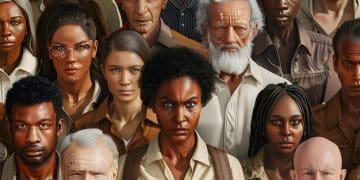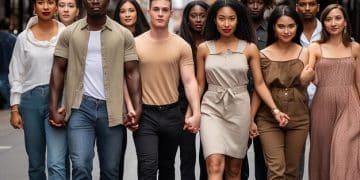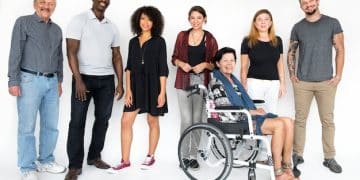US Demographics in 2025: Reshaping Cultural Narratives
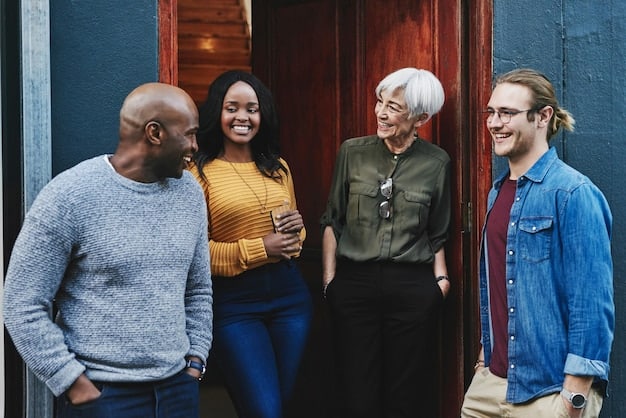
The 2025 shift in US demographics is fundamentally altering cultural narratives, broadening representations across media, arts, and mainstream discourse, reflecting a more diverse and interconnected national identity.
The United States stands at a pivotal juncture, with demographic shifts poised to fundamentally alter its societal fabric. By 2025, the nation’s cultural landscape will reflect a profound transformation, driven by evolving racial, ethnic, and age distributions. Understanding How the 2025 Shift in US Demographics is Reshaping Cultural Narratives is crucial for grasping the emerging identity of American society.
the evolving mosaic: diversity in numbers
The demographic landscape of the US is undergoing a profound metamorphosis. Projections for 2025 indicate a continuation of trends that have been reshaping the nation for decades, primarily characterized by increasing racial and ethnic diversity and shifts in age distribution. These numbers are not just statistics; they represent lives, experiences, and perspectives that collectively influence the cultural narrative.
By 2025, no single racial or ethnic group will constitute a majority of the youth population in the US. This “majority-minority” status among younger generations foreshadows a future where multiculturalism is not an aspiration but a lived reality across all segments of society. The implications for cultural expression are vast, demanding a re-evaluation of what constitutes mainstream American identity.
the rise of multiracial and multiethnic identities
One of the most compelling aspects of this demographic shift is the rapid growth of individuals identifying as multiracial or multiethnic. This group often navigates complex cultural intersections, bringing unique perspectives to art, media, and social discourse.
- Blurring lines: Traditional racial categories are becoming increasingly fluid.
- New narratives: Stories of mixed heritage are gaining prominence in literature and film.
- Cultural synthesis: The blending of traditions and perspectives enriches American culture.
This growing segment challenges the long-standing, often binary, notions of race in America, pushing for a more inclusive and nuanced understanding of identity. Their experiences are instrumental in crafting new cultural narratives that reflect a hybridized reality.
ageing populations and generational divides
Beyond race and ethnicity, age demographics also play a significant role. The aging of the Baby Boomer generation alongside the emergence of Generation Z and Alpha, creates a dynamic interplay of values, technological proficiency, and social priorities.
Each generation brings its own set of cultural touchstones and expectations. While older generations may cling to traditional forms of media and storytelling, younger demographics are digital natives, shaping culture through social media, online platforms, and a more globalized perspective. This generational confluence necessitates narratives that are both historically informed and future-oriented, bridging gaps and fostering intergenerational understanding.
The increasing diversity, both ethnically and generationally, ensures that cultural narratives in 2025 will be more layered and multifaceted than ever before. This shift demands a more inclusive and representative approach to media, arts, and public discourse.
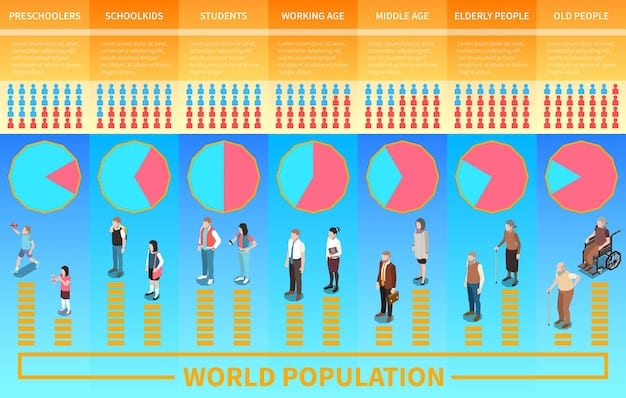
media and entertainment: a mirroring of reality
Cultural narratives are perhaps most visibly shaped and disseminated through media and entertainment. As the US population diversifies, so too must its representation on screen, in print, and across digital platforms. The demand for authentic storytelling that reflects the lived experiences of a broader audience is no longer negotiable; it’s a commercial and social imperative.
The shift is evident in casting choices, plotlines, and the types of stories greenlit by major studios and production houses. We are moving beyond tokenism towards genuine integration and leadership roles for diverse voices. This extends beyond merely populating a cast with diverse actors; it involves empowering individuals from varied backgrounds in writing, directing, and producing roles, ensuring that narratives are told from an inside perspective rather than an outsider’s gaze.
representation and authenticity
Audiences today are highly attuned to authenticity. Generic cultural portrayals or stereotypes are quickly rejected. The diverse demographic of 2025 demands narratives that resonate with specific cultural nuances, traditions, and challenges. This means a richer tapestry of stories that explore different family structures, immigration experiences, religious practices, and socio-economic realities.
The success of shows and films featuring predominantly non-white casts or exploring LGBTQ+ themes is a testament to this demand. These productions are not just catering to niche markets; they are becoming mainstream, proving that universal appeal can be found in specific, authentic narratives. Such content fosters empathy and understanding across different segments of the population, crucial for a cohesively diverse society.
the rise of specialized content and streaming platforms
Streaming services have been particularly instrumental in accelerating this trend. Their global reach and data-driven approach allow them to identify and cater to underserved demographics with highly specific content. This model stands in contrast to traditional broadcast television, which historically aimed for a broader, often homogenized, audience.
- Niche appeal: Platforms can effectively target specific cultural groups.
- Global reach: US cultural narratives are increasingly influenced by international stories.
- Creator empowerment: More diverse creators find avenues for their work.
This fragmentation of media consumption means that while a single “mainstream” narrative might be harder to define, the aggregate of diverse stories forms a new, richer cultural whole. The expectation is that by 2025, the media landscape will be even more fragmented and pluralistic, reflecting the multifaceted national identity.
Ultimately, media and entertainment are not just reflecting demographic change; they are actively shaping the understanding and acceptance of diverse cultural narratives. This dynamic interplay will only intensify as the US population continues its path towards greater diversity.
language and communication: bridging divides
Language is a fundamental pillar of culture, and the demographic shifts are profoundly impacting how Americans communicate. While English remains the dominant language, the increasing prevalence of Spanish and a multitude of other languages is shaping public discourse, marketing strategies, and even artistic expression. This linguistic diversification challenges existing norms and creates new opportunities for cultural exchange and understanding.
By 2025, multilingualism will be an even more pronounced feature of American society. This isn’t just about the number of languages spoken; it’s about the influence these languages exert on cultural identity and communication patterns. The co-existence of multiple languages often leads to code-switching, linguistic innovations, and a deeper appreciation for diverse modes of expression.
the growing influence of spanish
Spanish is undoubtedly the second most prevalent language in the US, with its influence extending far beyond Spanish-speaking households. Its presence is felt in advertising, public services, and educational institutions. This pervasive presence is already altering elements of American culture, from culinary trends to musical genres.
- Bilingual media: More news outlets and entertainment cater to Spanish speakers.
- Linguistic integration: Spanish words and phrases increasingly enter common parlance.
- Cultural fusion: Music genres like Latin Pop and Reggaeton gain mainstream appeal.
The growth of the Hispanic population means that Spanish will continue to be a vital component of the American linguistic tapestry, fostering a richer and more complex cultural conversation. This requires an emphasis on inclusivity in communication, ensuring that important messages reach all segments of the population effectively.
beyond english and spanish: a panorama of tongues
While Spanish is prominent, the US is also home to hundreds of other languages, spoken by communities from every corner of the globe. These languages often serve as vital anchors for cultural identity within immigrant communities, preserving traditions and fostering community cohesion. Official recognition, translation services, and cultural preservation efforts become increasingly important.
The challenge lies in ensuring that these voices are not marginalized but instead integrated into the broader cultural dialogue. This inclusive approach to language helps reinforce the idea that American identity is not monolithic, but rather a dynamic blend of many different cultural origins. Ultimately, the evolving linguistic landscape of the US in 2025 will demand greater adaptability, inclusivity, and an appreciation for the power of diverse communication.
food and fashion: culinary and sartorial melting pots
The cultural narrative of a nation is often vividly expressed through its food and fashion. As demographics shift, so too do the palates and preferences of the American public, reflecting a dynamic interplay of global influences and local adaptations. By 2025, the culinary and sartorial landscapes of the US will be more diverse than ever, challenging traditional notions of “American” cuisine and style.
The fusion of flavors and styles is not merely a trend; it’s a deep-seated cultural evolution driven by diverse immigration patterns and generational preferences. From the explosion of global street food markets to the appropriation and reinterpretation of traditional garments, food and fashion are tangible indicators of a nation in flux, constantly absorbing and transforming cultural elements.
the gastronomic revolution
American cuisine, once stereotyped as hamburgers and hot dogs, has undergone a metamorphosis. The influx of immigrants from Asia, Latin America, Africa, and other regions has introduced a vast array of ingredients, cooking techniques, and dining experiences. This enrichment is evident in restaurants, supermarkets, and home kitchens across the country.
- Ethnic food popularity: Ethiopian, Vietnamese, Korean, and other cuisines become mainstream.
- Fusion dishes: Chefs blend traditions to create innovative culinary experiences.
- Dietary diversity: Vegan, vegetarian, and allergen-conscious diets gain traction, often rooted in diverse cultural practices.
By 2025, a truly “American” meal might feature ingredients and cooking methods from several different cultural traditions, illustrating a culinary narrative that is fluid, inclusive, and globally influenced. This shift signifies a broader acceptance and celebration of multiculturalism.
fashion as a statement of identity
Fashion too serves as a powerful medium for cultural expression and identity. The demographic shift translates into more diverse body types, skin tones, and cultural aesthetics influencing clothing design and marketing. Traditional garments from various cultures are being reinterpreted, worn, and celebrated, moving beyond niche markets into mainstream fashion.

The demand for inclusive sizing, representation of diverse models, and culturally sensitive designs is greater than ever. Brands that fail to acknowledge this diversity risk alienating a significant portion of the evolving consumer base. Fashion in 2025 will be less about monolithic trends and more about individual expression, informed by a rich tapestry of global influences and personal heritage.
Both food and fashion illustrate how everyday choices become cultural statements, mirroring the broader demographic shifts. These realms offer constant opportunities for cultural sharing and transformation, making them vital components of the evolving American narrative.
politics and social discourse: new voices, new priorities
The demographic transformation of the US has profound implications for its political landscape and social discourse. As the electorate becomes more racially and ethnically diverse, and as different generations assert their priorities, the issues debated, the policies pursued, and the very definition of national interest are subject to re-evaluation. By 2025, these shifts will be shaping political power dynamics and public conversations in tangible ways.
The increased political engagement of diverse communities, spurred by evolving voting patterns and increased civic participation, ensures that their concerns are brought to the forefront. This leads to a richer, albeit sometimes more contentious, social discourse where multiple perspectives vie for prominence, challenging the status quo and demanding more inclusive governance.
electoral shifts and political power
The changing racial and ethnic composition of the US population directly impacts electoral outcomes, particularly in key battleground states. Minority groups, once considered peripheral, are increasingly pivotal in determining election results at local, state, and national levels. This translates into greater political representation and an increased focus on issues disproportionately affecting these communities.
Political parties are forced to adapt their messaging and platforms to appeal to a more diverse base. This necessitates a nuanced understanding of varying cultural values, economic aspirations, and social concerns. The rise of minority leaders and advocates within political structures further bolsters the influence of these demographic shifts on national policy and priorities.
the evolving nature of social justice conversations
Demographic change also fuels the evolution of social justice movements and conversations. Topics such as racial equity, immigration reform, LGBTQ+ rights, and environmental justice gain new urgency and broader support as the population becomes more diverse and interconnected. Younger generations, often more attuned to issues of systemic inequality, play a significant role in driving these discussions.
- Broader advocacy: More diverse coalitions advocate for social change.
- Intersectional approaches: Understanding of overlapping identities informs activism.
- Digital mobilization: Social media amplifies diverse voices in political debates.
The discourse moves beyond singular issues to embrace intersectionality, acknowledging that individuals hold multiple identities that shape their experiences of privilege and oppression. This more complex understanding fosters a demand for comprehensive solutions that address the root causes of inequality rather than superficial symptoms. The political and social scenes of 2025 will be characterized by a relentless push for a more equitable and representative society, driven by the diverse voices of its citizenry.
education and learning: fostering inclusive narratives
Education is a cornerstone of cultural transmission and a critical arena where demographic shifts significantly influence narratives. As US classrooms become more diverse, there is an imperative to transform curricula, teaching methodologies, and institutional practices to be more inclusive and representative of all students. By 2025, the education system will be increasingly focused on fostering narratives that accurately reflect the multicultural reality of the nation.
This transformation goes beyond merely adding diverse authors to reading lists; it involves a fundamental rethinking of how history is taught, whose voices are amplified, and how cultural competency is developed. The goal is to prepare students not just academically, but also socially and culturally, for a complex and interconnected world.
curriculum reform and diverse perspectives
Traditional curricula, often centered on Eurocentric perspectives, are being challenged and revised to incorporate a broader range of histories, literatures, and scientific contributions from various cultures. This ensures that students from diverse backgrounds see themselves reflected in the learning material, fostering a sense of belonging and academic engagement.
- Multicultural literature: Authors from diverse backgrounds enrich reading lists.
- Global history: Emphasis on non-Western civilizations and their impact.
- Social studies integration: Discussions on race, identity, and social justice become central.
Such reforms are crucial for developing a more holistic understanding of American history and identity, acknowledging the contributions and experiences of all its people. This also helps to combat cultural biases and stereotypes, promoting empathy and mutual respect among students.
bilingual education and language preservation
The demographic shift also underscores the growing importance of bilingual education and efforts to preserve non-English languages. For many immigrant families, maintaining their native language is a crucial aspect of cultural identity and familial connection. Educational institutions are increasingly recognizing the value of bilingualism, not just as a skill but as a cultural asset.
Programs that support English language learners while also fostering their native languages are becoming more common. This approach not only aids in academic success but also promotes cultural pride and prevents linguistic erosion. By valuing and supporting linguistic diversity, schools contribute significantly to inclusive cultural narratives, ensuring that differing backgrounds are seen as strengths rather than hindrances. The educational landscape of 2025 will be one that champions diverse learning environments, reflecting the rich cultural mosaic of its student body.
the workplace and economy: adapting to new realities
The American workplace and economy are inextricably linked to demographic shifts, influencing everything from hiring practices and corporate culture to consumer markets and innovation. By 2025, businesses and organizations will be navigating a highly diverse workforce and consumer base, requiring significant adaptations in leadership, marketing, and product development to thrive in this evolving environment.
The narratives of success and opportunity in the professional world are being rewritten to accommodate a broader range of experiences and expectations. This involves moving beyond superficial diversity metrics to genuinely foster inclusive environments where varied perspectives are not just tolerated but actively sought out and integrated into decision-making processes.
diversity and inclusion as economic drivers
Companies are increasingly recognizing that diversity and inclusion are not just ethical imperatives but strategic business advantages. A diverse workforce brings a wider range of ideas, problem-solving approaches, and market insights, leading to greater innovation and profitability. This awareness is driving changes in recruitment, retention, and leadership development.
- Targeted recruitment: Efforts to attract talent from underrepresented groups.
- Inclusive leadership: Training for managers to foster diverse teams.
- Cultural competency: Emphasizing understanding and respect for diverse backgrounds.
The economic narrative is therefore shifting from a focus on homogenous skill sets to valuing heterogeneity as a source of competitive advantage. Businesses that fail to adapt risk losing out on top talent and alienating significant portions of the consumer market. This also means that internal cultural narratives within organizations are becoming more complex and multifaceted.
consumer markets and tailored approaches
The demographic shift has also revolutionized consumer markets. As the US population diversifies, so do consumer preferences, purchasing power, and communication channels. Businesses must understand the cultural nuances, values, and media consumption habits of different ethnic and generational groups to effectively market their products and services.
This leads to more tailored marketing campaigns, culturally specific product lines, and an increased emphasis on representation in advertising. Generic, one-size-fits-all approaches are becoming obsolete. The economic success of businesses in 2025 will hinge on their ability to authentically engage with and cater to a diverse consumer base, crafting narratives that resonate deeply with different cultural identities. The economic and workplace narratives will continue to evolve, reflecting the ongoing and profound demographic restructuring of the US.
| Key Aspect | Brief Description |
|---|---|
| 🌍 Diverse Population | Youth population becoming “majority-minority,” increasing multiracial identities. |
| 🎬 Media Representation | Greater demand for authentic, diverse stories in film, TV, and streaming. |
| 🗣️ Linguistic Shifts | Spanish influence grows; emphasis on multilingualism and language preservation. |
| 🍽️ Fashion & Food | Culinary fusions and diverse fashion trends reflecting global influences. |
frequently asked questions about demographic shifts
By 2025, the most significant change is the continuing trend towards “majority-minority” status among younger generations. This means no single racial or ethnic group will constitute a majority of the youth population, profoundly influencing future cultural and social dynamics across the United States. This shift makes multiculturalism a central feature of national identity.
Media and entertainment will increasingly prioritize authentic representation, moving beyond tokenism to empower diverse voices in writing, directing, and acting roles. Streaming platforms will continue to cater to niche markets while global influences will further enrich content. The focus will be on narratives that genuinely reflect the diverse experiences and cultural nuances of the US population.
The demographic changes will lead to a more multilingual US. The influence of Spanish will grow significantly, with more bilingual media and integration into common parlance. There will also be increased recognition and preservation efforts for a multitude of other languages, enriching communication and promoting cultural exchange across various communities.
Demographic shifts will alter political power dynamics by making diverse communities more pivotal in elections. Political parties will need to adapt their messaging to appeal to a broader base. Social justice conversations will prioritize racial equity, immigration reform, and intersectionality, driven by diverse coalitions and younger generations demanding more inclusive policies and governance.
Diversity and inclusion will be crucial for the 2025 workplace. Businesses will recognize that a diverse workforce drives innovation, offers broader market insights, and attracts top talent. Companies will implement targeted recruitment and inclusive leadership training. This shift will influence everything from corporate culture to consumer markets, shaping economic narratives of success.
conclusion
The demographic shifts anticipated by 2025 are not merely statistical projections; they represent a fundamental reimagining of American identity and culture. Each facet, from media representation to political discourse, from linguistic diversity to culinary habits, will bear the imprint of a nation in constant evolution. Understanding and embracing these changes is paramount, not just for policymakers and businesses, but for every citizen engaging with the evolving cultural narratives. The United States is poised to become an even richer, more complex, and dynamically interconnected society, where diverse voices and experiences converge to form a new and vibrant national tapestry.
